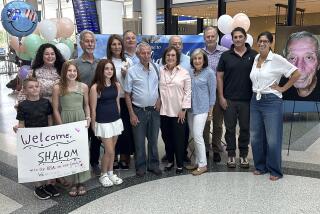Siegfried Halbreich dies at 98; Holocaust survivor lectured on his experience
Siegfried Halbreich, a survivor of four Nazi concentration camps who devoted the second half of his long life to public education about the horrors that Jews experienced during World War II, died of heart failure Wednesday at his Beverly Hills home. He was 98.
Halbreich was among the first Jews to be sent to the camps in 1939. Five-and-a-half years later, he was one of the few to emerge alive.
After moving to Los Angeles in 1960, he became one of the Holocaust’s most vocal witnesses, giving talks in elementary schools, high schools, colleges, churches and synagogues. By the time he stopped, about three years ago, he had given 2,500 free lectures around the world on the abominations he lived through during Hitler’s reign.
“Very few people were imprisoned as long and in as many prisons as he was,” said John K. Roth, a Holocaust scholar and professor emeritus at Claremont McKenna College, who frequently invited Halbreich to speak to his classes. But he said what Halbreich accomplished after leaving the camps was also extraordinary.
“He would speak with great truthfulness about the hard things he had seen and endured. But there was always a note of determination to go forward,” Roth said, “to help people remember that the world can be a brutal and nasty place, but that it doesn’t have to be that way.”
In 1996, Halbreich told a group of Riverside high school students that it was “not a pleasure to go . . . from place to place to talk about the horrible past we had to endure. But I feel it is my obligation to tell people what was going on and to warn them. This,” he said of the Nazi’s campaign of extermination, “should never happen again to anyone.”
Halbreich was born Nov. 13, 1909, in the town of Dziedzice in what is now southern Poland. He had a degree from the University of Krakow and worked as a pharmacist until the war began.
In 1939, after the German army occupied Poland, he tried to escape to what was then Yugoslavia, but he was caught and deported to the Sachsenhausen camp north of Berlin, where he and 400 other prisoners were jammed into a barracks built for 100.
In 1941, he was transferred to the Gross-Rosen camp in what is now Rogoznica, Poland. A year later, he was sent to Auschwitz, where, because of his pharmacy training, he was assigned to work in the camp hospital.
Secretly he led resistance efforts, he told The Times in a 2004 interview. He sheltered younger prisoners, gave them food and medicine and helped many escape the brutality of their captors.
He was at Nordhausen-Dora, a forced-labor camp in central Germany, for a year before it was liberated by Allied forces in April 1945.
After the war, Halbreich, who spoke several languages, worked with the United States government’s War Crimes Branch as an interpreter and investigator.
He testified at the trials of Nazi war criminals and gave testimony that was used in the prosecution of Adolf Eichmann, the German high official who was hanged in Israel for his role in the Holocaust.
In 1946 Halbreich immigrated to the U.S., and he spent the next 13 years in Cleveland, where he and his wife, Ruth, started a family. In addition to his wife, he is survived by a son, Jeremy, of Dallas; a daughter, Emily Tigerman, of Sherman Oaks; and two grandchildren.
He left Cleveland in 1959, in part to escape the past that came up every time a well-meaning relative asked about his wartime imprisonment. He moved to Beverly Hills and ran a custom picture framing business in Santa Monica. “Questions, questions, so many questions. I didn’t want to talk much about what I had been through,” he told the Cleveland Plain Dealer in 2000.
But in 1960, after a visit to Israel, his rabbi asked him to give a talk about the Holocaust. Halbreich agreed to tell his story -- and he told it again and again over the next 45 years.
He spoke of losing his parents and both his brothers.
He spoke of seeing Jews treated worse than cattle on trains bound for gas chambers, of a Nazi commander who sent Jews to hard labor or death with the casual flick of a thumb, of fellow prisoners shot dead for no reason other than that they turned their heads at the wrong moment.
He recalled how one day after liberation, while serving as an interpreter for Gen. Dwight Eisenhower, the Allied commander noticed the “68233” that the Nazis had imprinted on his skin and asked, “Did it hurt you very much when they tattooed this number on your arm?”
Halbreich, stunned, at first didn’t know what to say. He thought, “My gosh, what kind of people are the Americans? They see what’s going on here, full of bodies, dead people . . . and he asked if this was hurting? But later on, I understood, he had no idea. The Americans, it was strange to them to face something like this.”
He told his stories to anyone who wanted to listen, but never in a manner that was overwrought with emotion. “He was just low-key, understated. He honestly answered any question people put to him. He was masterful in that role,” Roth said.
He became an important figure in the Holocaust survivor community in Los Angeles. He served as president of the 1939 club, one of the largest and oldest organizations of survivors, and led a successful campaign to create an endowed chair in Holocaust studies at UCLA.
In 1991 he published a memoir, which he called “Before-During-After.” He also served as the model for the main character in a children’s book, “The Number on My Grandfather’s Arm,” by David A. Adler.
But it was the public speaking that kept him going well into his 90s. Michael Berenbaum, a Holocaust historian at American Jewish University, said he was not aware of any survivor who spoke as widely and as often about the Holocaust as Halbreich. “It took a certain tenacity. He didn’t live his life without tenacity,” said Berenbaum, who knew Halbreich for more than 25 years.
If there was a toll for his suffering so many years earlier, it rarely showed.
One day in 1980, however, Halbreich believed that he saw Nazi war criminal Josef Mengele playing piano in a Los Angeles nightclub with members of a German-Argentine band. Mengele’s death by drowning had been reported the year before in Brazil, but Halbreich was so certain he had discovered the infamous “Angel of Death” from Auschwitz that he reported the sighting to police.
Said Berenbaum: “He wanted to see Mengele, he wanted to confront him as a free man. Who wouldn’t want to do that?”
Halbreich was contacted by the FBI and the U.S. Immigration and Naturalization Service, but nothing more came of the incident.
In a 2000 documentary about survivors by David Notowitz, Halbreich said students often asked him if he had nightmares.
“Nightmares, dreams, I never do,” he said, “because I live with it, day and night.”
Funeral services will be held at noon today at Mount Sinai Memorial Park, 5950 Forest Lawn Drive, Los Angeles. Donations may be sent to the U.S. Holocaust Memorial Museum, c/o Sara Bloomfield, 100 Raoul Wallenberg Place, Washington, D.C., 20238.
More to Read
Start your day right
Sign up for Essential California for the L.A. Times biggest news, features and recommendations in your inbox six days a week.
You may occasionally receive promotional content from the Los Angeles Times.







